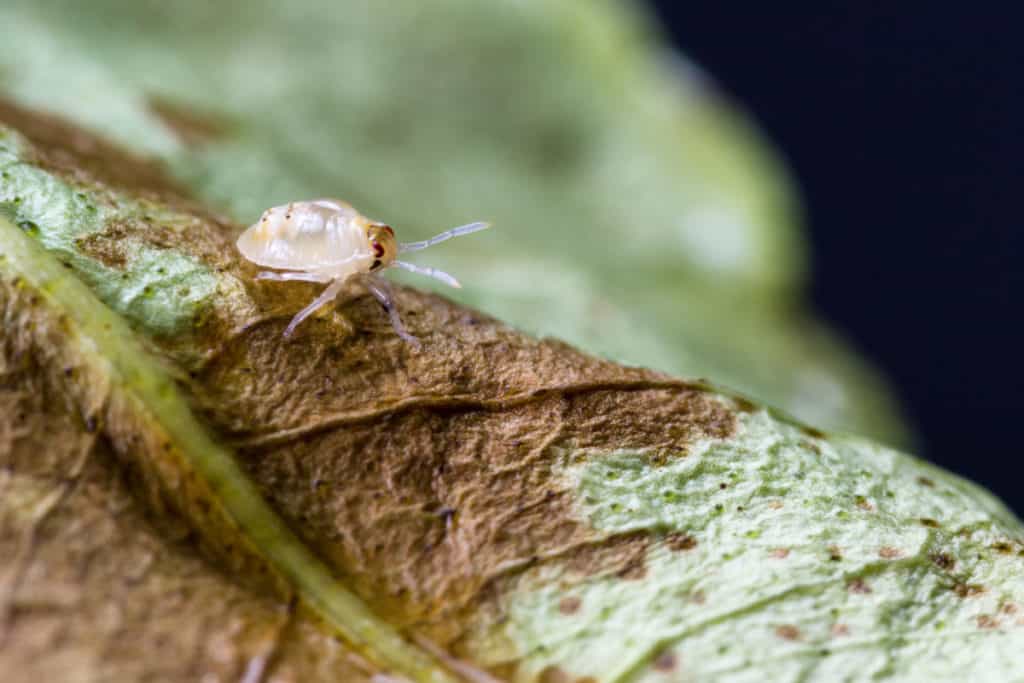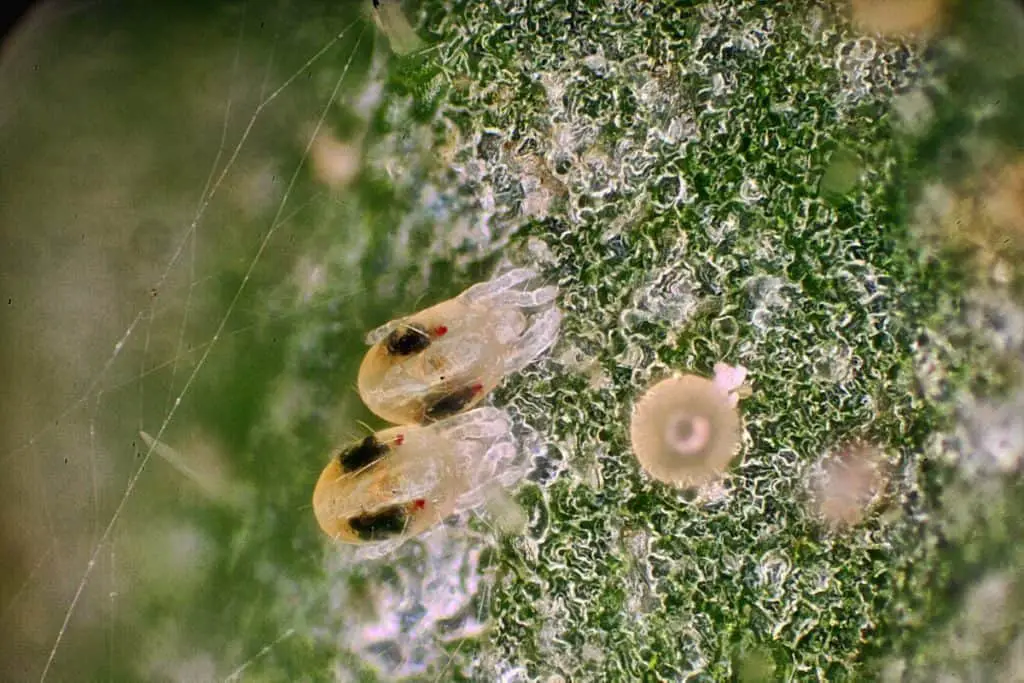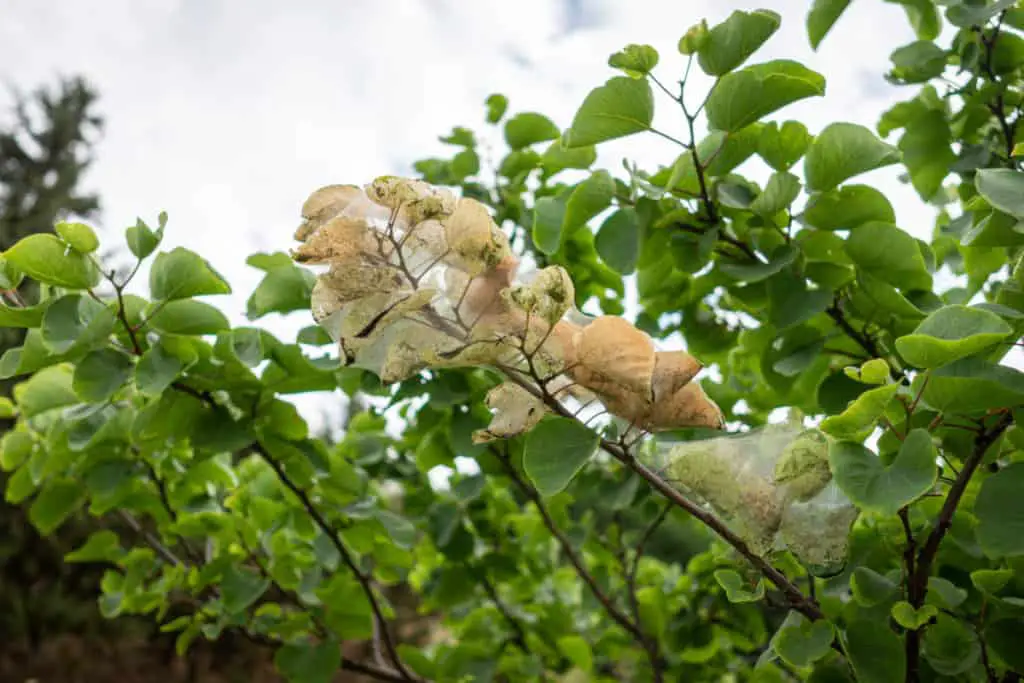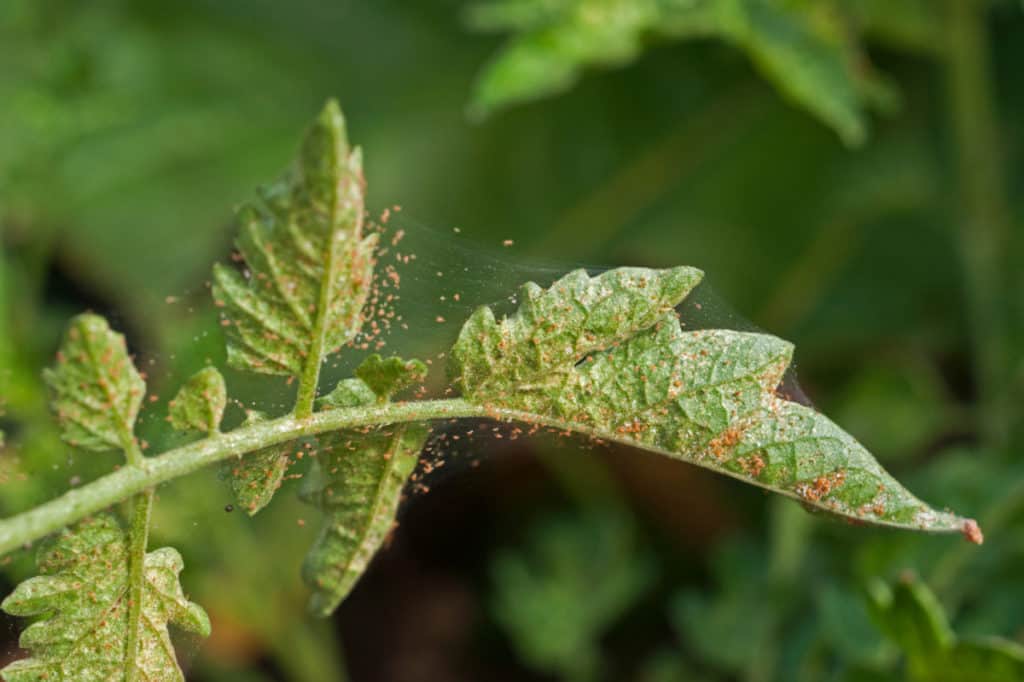If you have ever been greeted by yellowing, dusty-looking leaves covered in tiny spots and spider webs on your favorite plants, then you are probably familiar with spider mites and the damage they can cause all too well.
Close relatives of spiders, ticks, and scorpions, spider mites are tiny creatures feasting on common garden plants, making them archenemies to every gardener. To the unsuspecting gardener, these pesky invaders could cause devastation, especially as they only measure a millimeter in length, barely visible to the human eye.
So what is it that spider mites are eating?
Spider mites are eating the chlorophyll (the chemical that makes plants green) from the leaves of plants. This is devastating as it destroys the leaf’s ability to photosynthesize. The chlorophyll is critical to the process, allowing plants to convert sunlight, CO2, and water into food.

We’ll look at what spider mites eat, the potential damage they may cause if any, and the solutions to get rid of them once they are present in the garden. So, stick with us to learn how to recognize and safely remove the chlorophyll-hungry squatters.
What Do Spider Mites Eat?
One of spider mites’ strengths is their microscopic size which makes them almost invisible when they invade the garden- you’ll need a magnifying glass to see them properly.

Unlike many other pests, spider mites don’t eat large holes in leaves, but they come in large groups and cause damage quickly.
Targeting plants from small flowers, through shrubs, to trees, these small pests feed on the chlorophyll in the leaf cells, which prevents the leaves from photosynthesizing, restricting the plants to use the sunlight needed to create the energy.
The leaves begin to lose their color and turn yellow (due to the lack of chlorophyll), which might lead you to believe that it is due to a shortage of water. At this late stage, more water will not fix the yellowing leaves, as a lack of water is not the underlying problem.

Watering your plants can, however, unintentionally get rid of some of the spider mites, but it is not a full solution, nor is it a cure to a spider mite infestation.
Do Spider Mites Cause Damage Or Harm To What They Eat?
Anyone with spider mite experience knows that spider mites feed on your plants, and can kill them very easily if not treated early enough.
The more spider mites on a plant, the quicker the plant will die. Spider mites are reproducing like crazy with females laying up to hundreds of eggs in their lifetime.
The eggs hatch within a few days. New spider mite nymphs will emerge from the eggs in just 2-4 days and will mature in anything from 5-20 days, depending on the conditions. Adults can live for quite some time as well, so once a large population has established on your plants, chances of eradicating them and saving the plants could become impossible.
Plants with massive infestations can almost die overnight, and at this point, it is basically impossible to save the plant.
Because of their fast reproduction and the chlorophyll that they feed on, spider mites can be devastating to your garden if left unchecked.
Are Particular Plants More Susceptible To Spider Mites?
While there is a common assumption among gardeners that plants with thinner leaves are much more susceptible to spider mites, they feed on a variety of plants and are generally not very picky eaters.
One study suggests that spider mites have been recorded on more than 300 host plant species.
In vegetable gardens, spider mites will target different species including tomatoes, potatoes, eggplant, and vine crops. They also feed on herbs such as mint and even rosemary.
The pesky vermin will also munch on roses and fruit trees. Even plants kept inside the house can be a spider mite target, as indoor plants are sheltered from the elements such as rain and wind. There are a variety of house plants prone to spider mite attacks.
Most plants with broad, thin leaves could be an open invite to spider mites. Some plant families more at risk of spider mite invasion include Araliaceae, Marantaceae, and Apocynaceae. This is of course not set in stone and can depend on the conditions.
Some homeowners claim that indoor plants such as Jade, Rubber tree, and the snake plant are resistant to these destructive pests However, it is important to know what best grows in your climate or home.
Spider mites are tough and have even been recorded on cacti and succulents, even though these are not included in their list of preferred delicacies.
How Do You Know If You Have Spider Mites On Your Plants?
Once you know what to look out for, spider mites are much easier to identify. The damage appears at the top of the leaves and looks like stippling, little yellow or white dots.
The longer the spider mites stay, the more webs will be visible on the plant. Look out for this sign around the leaves and stems of the plant, as they use the webs as a way for them to travel around on the plant. This web also protects them against pesticides as it will not reach them as easily.
To be sure that it is indeed spider mites feeding on your plants, you can simply take a magnifying glass and have a look underneath the plant leaves.
Spotting webbing (somewhat like a spider web) and tiny red insects is an indication that there are spider mites on the plant.

You can observe this day-to-day basis for the spreading of the web, thus indicating that the population is growing.
It appears that some people confuse spider mites with clover mites. To help people be clear on the differences between these two mites we have written an article comparing the two. If you want to check it out the article is called, Clover Mites Vs Spider Mites: What is the Difference?
When Are Spider Mites Likely To Attack Your Plants?
Spider mites make their presence known when temperatures reach 27 degrees Celsius (80.6 degrees Fahrenheit).
They thrive in hot, dry conditions, so ensure your plants are not drought-dressed by watering regularly. Humid conditions give rise to pathogenic fungi, which can wipe out spider mite populations completely.
However, overwatering the plants could lead to additional problems, not to mention a fungal infection which could destroy your plant just the same as the spider mites could.
Using excessive pesticides is never good as this can wipe out the natural enemies of spider mites.
These include species such as lacewings, ladybugs, predatory midges, and other predatory mites.
Using pesticides should only be done in extreme cases.
If you are interested we have an entire article on what preys on spider mites. The article is called, What Eats Spider Mites?
Treating Spider Mites
There are several ways to treat spider mites.
- You can simply spray them with a hose pipe or a strong stream of water.
- Secondly, remove infected leaves and destroy them to prevent further spread. However, these leaves should not be added to your compost. If the plant is heavily infested, remove the entire plant.
- Natural oils such as neem, cottonseed, rosemary, or mint can be sprayed on plants to get rid of spider mites feeding on your plants.
- Spraying with water and insecticidal soap is probably one of the most effective treatments due to moisture levels. Also remove weeds, as these could also provide food for spider mites.
- Home-made extract mixtures containing hot peppers are said to be a solution, but it is only effective in killing about 45% of the adult population at a time. Rubbing alcohol and dishwashing liquid solutions can also be sprayed on the affected plant if caught early.
How To Prevent A Spider Mite Infestation?
Although there are many options when treating spider mites, one should always remember that prevention is better than cure.
There are ways to prevent spider mite infestations on your plants in the first place by ensuring healthy plants and surroundings.
- Ensure areas where spider mites were present previously, are cleaned properly during the cooler months. Pots that hosted plants that died due to spider mites should be soaked and cleaned, or completely destroyed.
- Maintain a well watered garden.
- Use plants less susceptible to a spider mite infestation.
The Garden of Eden Garden School offers valuable advice on the topic after thorough research on the technical side. Spider mites only occur on plants where there is an excess of photosynthesis sugars, but spider mites feeding on your plants can’t digest complex proteins in plants.
- Foliar feeding high in trace elements is a good way to keep spider mites at bay.
Fertilizers high in nitrogen may seem to cause no harm, but they cause even more photosynthesis, which just invites more spider mites in hot, dry conditions.
Options of products with trace elements include products such as Trelmix, Kelpak, or Nitrosol, however, not all of these brands are available worldwide.
Are Spider Mites A Risk To Commercial Crops?
Just like spider mites pose a risk to plants in the home garden, they can have a field day on commercial crops due to the large volumes of plants present at any given time.
As spider mites are so small, they can go undetected for a long time. The critters feed on commercial crops such as coffee, cotton, citrus trees, tobacco clover, wheat, beans, fruit trees, and vine plants such as squash and melons.
Spider mites generally prefer the underside of leaves, but in severe cases, they can damage more than the leaves alone, including the flowers and fruit produced by these plants. When left uncontrolled, entire crops can be destroyed within a week.
The entire stage of the spider mite can damage the plant. It is suggested to avoid planting eggplant crops adjacent to legume forage crops. Overhead irrigation or ample rain, as well as avoiding broad-spectrum insecticide applications early in the season can help.
Even plants in greenhouses are at risk from spider mites, so it is best to inspect crops regularly to ensure they are free from these pests.
The Wrap Up
A spider mite infestation can be devastating to a commercial crop grow or aesthetic garden. These tiny insects reproduce within days and can destroy a single plant overnight.
Spider mites and their nymphs feed on the chlorophyll from the leaves of plants, breaking down the ability of a plant to photosynthesize leading to the starvation of the plant.
Although these insects can be devastating to your plants, there are numerous natural ways to prevent and cure an infestation.
Always remember, the sooner you address your spider mite issue, the easier the cure will be.
If you are interested we have some other articles about what bugs eat. You can check them out below:
What Do Spiders Eat? (Their Fascinating Diets Revealed)
What Do Praying Mantis Eat? (With Video Hunting A Fish)
Vulture Bees: There Are Meat Eating Bees And They Make Honey
Sources
https://ag.umass.edu/vegetable/fact-sheets/two-spotted-spider-mite
https://infonet-biovision.org/PlantHealth/Pests/Spider-mites
https://www.growveg.co.za/pests/uk-and-europe/red-spider-mite/
https://www.prevention.com/life/a33263786/how-to-get-rid-of-spider-mites/
https://extension.sdstate.edu/dry-conditions-are-ideal-spider-mite-activity
https://homeguides.sfgate.com/indoor-plants-resistant-spider-mites-34439.html
https://ag.tennessee.edu/greenhouses/Documents/Pests%20and%20Control/TwoSpottedSpiderMite.pdf
https://www.sciencedaily.com/releases/2009/11/091102171613.htm
